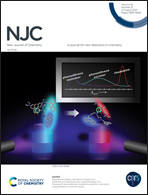Ultra-trace level detection of Cu2+ in an aqueous medium by novel Zn(ii)-dicarboxylato–pyridyl coordination polymers and cell imaging with HepG2 cells†
Abstract
Two newly designed coordination polymers (CPs), [Zn(adc)(4-Cltpy)(H2O)] (CP1) and [Zn(trans-muca)(4-Cltpy)] (CP2) (4-Cltpy = 4′-Chloro-2,2′:6′,2′′-terpyridine, H2adc = Acetylene-dicarboxylic acid, trans-H2muca = trans, trans-muconic acid), are synthesized and structurally characterized by single crystal X-ray crystallography, PXRD, TGA, IR and elemental analysis. The coordination unit gets polymerized through the bridging of dicarboxylic acids and a 1D chain has been constructed. The 1D chain undergoes self-assembly via H-bonding, C–H⋯π and π⋯π interactions. Interestingly, the 4′-chloro-2,2′:6′,2′′-terpyridine appended CPs are highly emissive in aqueous media and exhibit selective quenching by Cu2+ ions; the calculated (3σ method) limits of detection (LODs) are 0.14 μM (CP1) and 0.06 μM (CP2), respectively. Microscopic cell imaging determines the internalization of CPs within HepG2 cells. An MTT assay displays a tolerance limit of 100 μM.



 Please wait while we load your content...
Please wait while we load your content...